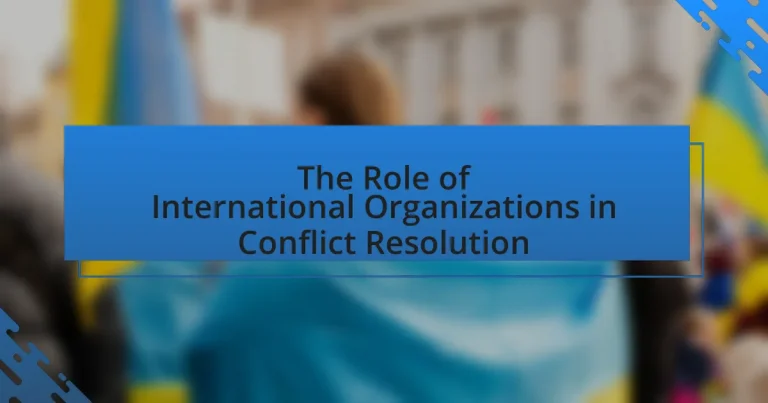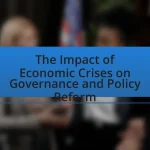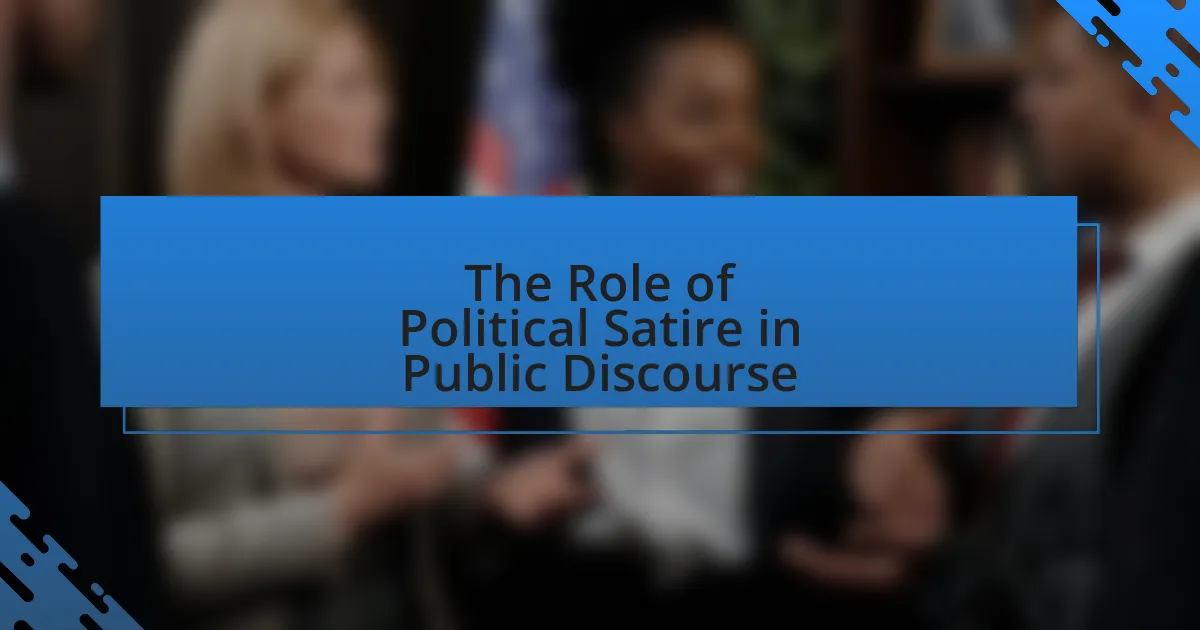International organizations, such as the United Nations and the African Union, play a vital role in conflict resolution by facilitating dialogue, providing mediation, and deploying peacekeeping forces. They contribute to peacekeeping efforts through personnel deployment, humanitarian assistance, and post-conflict reconstruction, while also establishing norms and platforms for dialogue to foster cooperation among conflicting parties. The article explores the functions, challenges, and strategies of these organizations in conflict zones, highlighting their unique advantages in mediation and the importance of collaboration with local entities. Additionally, it examines successful case studies and lessons learned from past efforts, emphasizing best practices for enhancing the effectiveness of international organizations in achieving sustainable peace.
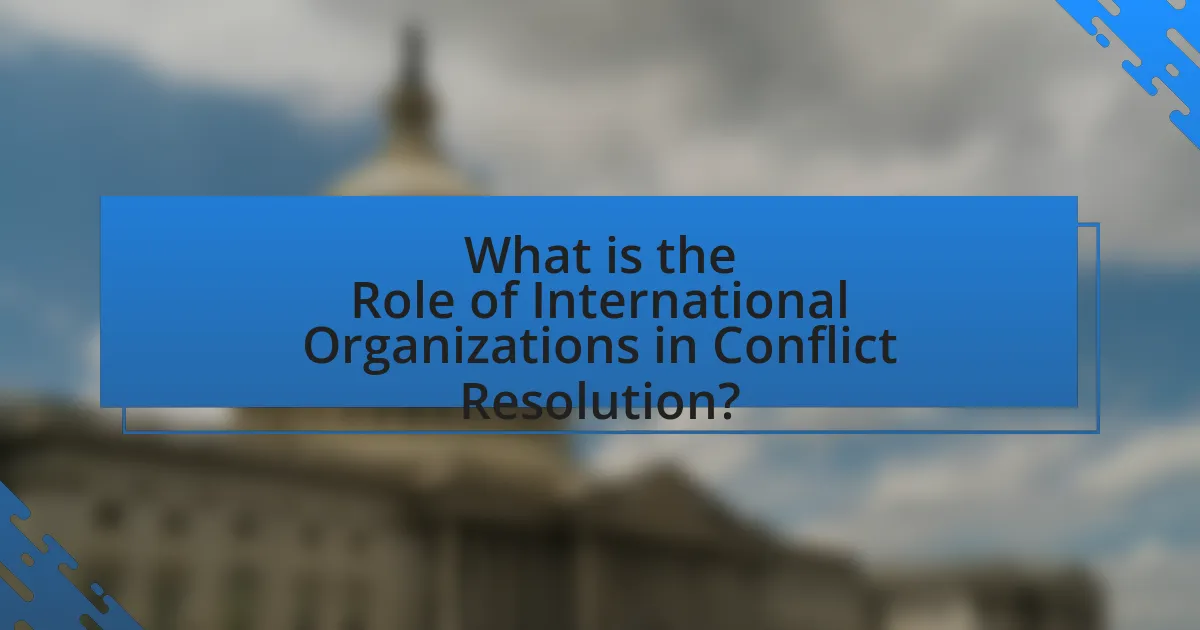
What is the Role of International Organizations in Conflict Resolution?
International organizations play a crucial role in conflict resolution by facilitating dialogue, providing mediation, and deploying peacekeeping forces. These entities, such as the United Nations and the African Union, often act as neutral parties to help conflicting sides reach agreements. For instance, the United Nations has been involved in over 70 peacekeeping missions since its inception, demonstrating its commitment to maintaining international peace and security. Additionally, international organizations can offer resources and expertise in conflict management, which can lead to more sustainable resolutions. Their involvement often helps to legitimize the peace process and encourages compliance from conflicting parties, as seen in the Dayton Accords, where the U.S. and NATO played significant roles in mediating the Bosnian War.
How do international organizations contribute to peacekeeping efforts?
International organizations contribute to peacekeeping efforts by deploying personnel and resources to conflict zones, facilitating negotiations, and providing humanitarian assistance. For instance, the United Nations has conducted over 70 peacekeeping missions since 1948, which have included military, police, and civilian components aimed at stabilizing regions and protecting civilians. These missions often involve monitoring ceasefires, disarming combatants, and supporting the establishment of governance structures. Additionally, organizations like the African Union and NATO have also engaged in peacekeeping operations, enhancing regional stability through collaborative efforts. The effectiveness of these organizations is evidenced by the reduction of violence in areas where peacekeeping forces are present, as seen in countries like Liberia and Sierra Leone following UN interventions.
What are the key functions of international organizations in conflict zones?
International organizations in conflict zones primarily function to provide humanitarian assistance, facilitate peace negotiations, and support post-conflict reconstruction. Humanitarian assistance includes delivering food, medical care, and shelter to affected populations, as seen in the efforts of the United Nations and the International Red Cross during crises like the Syrian Civil War. Facilitating peace negotiations involves mediating between conflicting parties to reach agreements, exemplified by the role of the African Union in peace talks in South Sudan. Supporting post-conflict reconstruction includes rebuilding infrastructure and institutions, as demonstrated by the World Bank’s involvement in Iraq after the 2003 invasion. These functions are critical for stabilizing conflict-affected regions and promoting long-term peace.
How do these functions facilitate conflict resolution?
International organizations facilitate conflict resolution by providing mediation, establishing norms, and offering platforms for dialogue. Mediation by organizations like the United Nations helps conflicting parties find common ground, as seen in the UN’s role in the peace process in Colombia, which led to a historic peace agreement in 2016. Establishing norms, such as the Responsibility to Protect doctrine, encourages states to act against atrocities, thereby preventing conflicts from escalating. Additionally, platforms for dialogue, such as the Organization for Security and Co-operation in Europe, enable ongoing communication and negotiation, which are crucial for de-escalating tensions and fostering cooperation among nations.
Why are international organizations essential in mediating conflicts?
International organizations are essential in mediating conflicts because they provide a neutral platform for dialogue and negotiation among conflicting parties. Their established credibility and expertise in conflict resolution facilitate trust-building, which is crucial for effective mediation. For instance, the United Nations has successfully mediated numerous conflicts, such as the peace process in El Salvador during the 1990s, where its involvement led to a significant reduction in violence and the establishment of a democratic government. This demonstrates that international organizations can leverage their resources and diplomatic influence to foster peaceful resolutions, making them vital actors in global conflict mediation.
What unique advantages do international organizations have in mediation?
International organizations possess unique advantages in mediation, primarily due to their neutrality, resources, and established legitimacy. Their neutral stance allows them to facilitate dialogue between conflicting parties without bias, which is crucial for building trust. Additionally, international organizations often have access to significant financial and logistical resources, enabling them to support mediation processes effectively. For instance, the United Nations has a long history of mediating conflicts, leveraging its global presence and expertise to foster peace negotiations. Furthermore, their legitimacy, derived from international recognition and support from member states, enhances their ability to influence parties and encourage compliance with mediation outcomes.
How do they build trust among conflicting parties?
International organizations build trust among conflicting parties by facilitating dialogue and promoting transparency. They create neutral platforms for communication, allowing parties to express their concerns and grievances openly. For example, the United Nations often mediates peace talks, providing a structured environment where conflicting parties can negotiate terms without fear of bias. Additionally, these organizations implement confidence-building measures, such as joint projects or monitoring agreements, which foster cooperation and demonstrate commitment to peaceful resolutions. Research indicates that such initiatives can significantly reduce tensions and enhance mutual understanding, as seen in various peace processes facilitated by organizations like the Organization for Security and Co-operation in Europe (OSCE).
What challenges do international organizations face in conflict resolution?
International organizations face several challenges in conflict resolution, including political bias, lack of resources, and difficulties in achieving consensus among member states. Political bias can hinder impartiality, as organizations may favor certain parties over others, impacting their credibility. Additionally, limited financial and human resources restrict their ability to implement effective interventions. Furthermore, achieving consensus is often complicated by differing national interests and priorities, which can delay or obstruct decision-making processes. These challenges are evident in various case studies, such as the United Nations’ struggles in the Syrian conflict, where political divisions among member states have impeded effective action.
How do political interests affect their effectiveness?
Political interests significantly affect the effectiveness of international organizations in conflict resolution by shaping their agendas, priorities, and actions. When member states prioritize their national interests over collective goals, it can lead to gridlock and inefficiency in decision-making processes. For example, the United Nations Security Council often faces challenges in passing resolutions due to the conflicting political interests of its permanent members, which can hinder timely and effective responses to conflicts. This dynamic illustrates how divergent political agendas can obstruct the ability of international organizations to act decisively, ultimately impacting their overall effectiveness in resolving conflicts.
What limitations do they encounter in operational capacity?
International organizations encounter limitations in operational capacity primarily due to funding constraints, political disagreements among member states, and logistical challenges in conflict zones. Funding constraints often lead to insufficient resources for effective intervention, as seen in the United Nations’ peacekeeping missions, which frequently operate with budget shortfalls. Political disagreements among member states can hinder decision-making processes, delaying responses to crises, as evidenced by the Security Council’s inability to reach consensus on various conflicts. Logistical challenges, such as security risks and infrastructure damage in conflict areas, further complicate operational effectiveness, limiting the ability to deliver aid and implement peace initiatives.
How do international organizations collaborate with local entities?
International organizations collaborate with local entities through partnerships that leverage local knowledge and resources to address conflict resolution effectively. These collaborations often involve capacity building, where international organizations provide training and technical assistance to local entities, enhancing their ability to manage conflicts. For instance, the United Nations Development Programme (UNDP) has implemented programs that empower local governance structures in post-conflict areas, facilitating community dialogue and reconciliation efforts. Additionally, international organizations may engage in joint initiatives with local NGOs to implement peacebuilding projects, ensuring that local perspectives and needs are integrated into the conflict resolution process. This approach not only fosters local ownership of peace initiatives but also increases the sustainability of outcomes, as evidenced by successful case studies in countries like Liberia and Sierra Leone, where local entities played a crucial role in the peacebuilding process supported by international organizations.
What strategies enhance the effectiveness of international organizations in conflict resolution?
International organizations enhance their effectiveness in conflict resolution through strategies such as mediation, capacity building, and fostering inclusive dialogue. Mediation involves facilitating negotiations between conflicting parties, which has been shown to lead to more sustainable peace agreements, as evidenced by the success of the United Nations in various peace processes. Capacity building strengthens local institutions and governance structures, enabling communities to manage conflicts independently; for instance, the Organization for Security and Co-operation in Europe has implemented programs that empower local actors in conflict zones. Additionally, fostering inclusive dialogue ensures that all stakeholders, including marginalized groups, are represented in the resolution process, which has been linked to more durable peace outcomes, as seen in the peace agreements in Colombia.
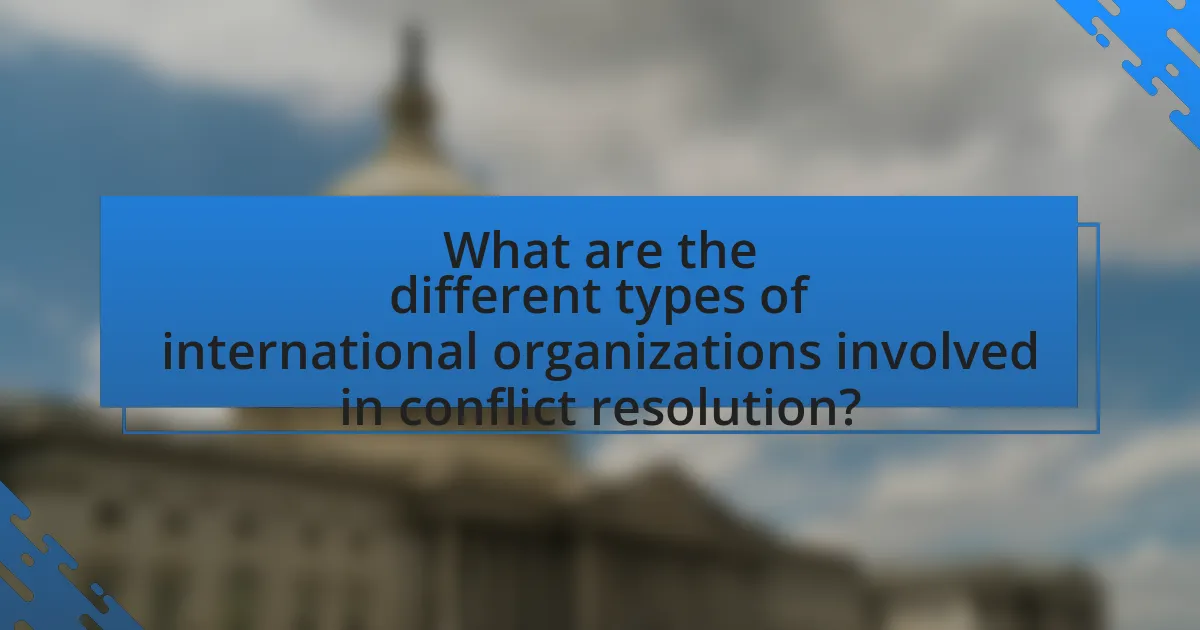
What are the different types of international organizations involved in conflict resolution?
International organizations involved in conflict resolution include intergovernmental organizations, non-governmental organizations, and regional organizations. Intergovernmental organizations, such as the United Nations, play a crucial role by facilitating negotiations, deploying peacekeeping missions, and providing platforms for dialogue among conflicting parties. Non-governmental organizations, like the International Crisis Group, contribute by offering analysis, advocacy, and on-the-ground support to mitigate conflicts. Regional organizations, such as the African Union and the European Union, engage in conflict resolution through regional diplomacy, peacekeeping operations, and conflict prevention initiatives. These organizations collectively enhance global efforts to address and resolve conflicts effectively.
What roles do the United Nations play in conflict resolution?
The United Nations plays several critical roles in conflict resolution, primarily through peacekeeping, mediation, and the establishment of international norms. Peacekeeping missions, authorized by the UN Security Council, deploy personnel to conflict zones to maintain peace and security, as seen in missions like those in Cyprus and the Democratic Republic of the Congo. Mediation efforts involve facilitating dialogue between conflicting parties, exemplified by the UN’s role in peace negotiations in countries such as Colombia and Yemen. Additionally, the UN promotes international norms and frameworks, such as the Responsibility to Protect doctrine, which guides member states in preventing mass atrocities. These roles are supported by the UN’s ability to mobilize international resources and foster cooperation among nations, thereby enhancing its effectiveness in resolving conflicts.
How does the UN Security Council address conflicts?
The UN Security Council addresses conflicts primarily through diplomatic measures, sanctions, and peacekeeping operations. It employs resolutions to impose sanctions on aggressor states, facilitate negotiations, and authorize peacekeeping missions to stabilize regions in conflict. For instance, the Security Council has authorized over 70 peacekeeping operations since its inception, including the United Nations Stabilization Mission in Haiti (MINUSTAH) in 2004, aimed at restoring order and supporting political processes. These actions are grounded in the UN Charter, which empowers the Security Council to maintain international peace and security, demonstrating its critical role in conflict resolution.
What peacekeeping missions has the UN undertaken?
The United Nations has undertaken numerous peacekeeping missions globally, including notable operations such as the United Nations Emergency Force in 1956, the United Nations Peacekeeping Force in Cyprus established in 1964, and the United Nations Multidimensional Integrated Stabilization Mission in Mali initiated in 2013. These missions aim to maintain peace and security in conflict-affected areas, often involving military personnel, police, and civilian staff. The effectiveness of these missions is evidenced by their role in stabilizing regions, facilitating humanitarian assistance, and supporting the implementation of peace agreements, as seen in the successful transition to peace in countries like Liberia and Sierra Leone.
What is the role of regional organizations in conflict resolution?
Regional organizations play a crucial role in conflict resolution by facilitating dialogue, mediating disputes, and providing platforms for negotiation among member states. These organizations, such as the African Union and the European Union, often have the regional knowledge and political leverage necessary to address conflicts effectively. For instance, the African Union has intervened in various conflicts, such as in Sudan and South Sudan, by deploying peacekeeping missions and mediating peace agreements, demonstrating their capacity to influence outcomes in regional disputes. Additionally, regional organizations can mobilize resources and support from member states to implement conflict resolution strategies, enhancing their effectiveness in maintaining peace and stability.
How do organizations like the African Union contribute to peace efforts?
Organizations like the African Union contribute to peace efforts by facilitating dialogue, deploying peacekeeping missions, and promoting conflict resolution strategies among member states. The African Union has established mechanisms such as the African Peace and Security Architecture, which includes the African Standby Force, aimed at rapid deployment in conflict situations. For instance, the African Union intervened in the Darfur conflict by sending peacekeeping troops under the African Union-United Nations Hybrid Operation in Darfur (UNAMID), which was a significant step in addressing violence and protecting civilians. Additionally, the African Union mediates peace agreements, exemplified by its role in the peace process in South Sudan, where it helped broker a ceasefire and facilitated negotiations between conflicting parties. These actions demonstrate the African Union’s commitment to maintaining peace and stability across the continent.
What are the benefits of regional approaches to conflict resolution?
Regional approaches to conflict resolution enhance effectiveness by leveraging local knowledge and fostering ownership among affected communities. These approaches often result in tailored solutions that consider the unique cultural, political, and social dynamics of the region, leading to more sustainable peace. For instance, the African Union’s peacekeeping missions have demonstrated success in addressing conflicts in Somalia and South Sudan by utilizing regional actors who understand the context better than external forces. Additionally, regional organizations can mobilize resources and support more rapidly than global entities, as seen in the Economic Community of West African States (ECOWAS) interventions in Liberia and Sierra Leone, which were crucial in restoring stability.
How do non-governmental organizations (NGOs) support international organizations?
Non-governmental organizations (NGOs) support international organizations by providing essential resources, expertise, and grassroots connections that enhance the effectiveness of conflict resolution efforts. NGOs often conduct field research, gather data, and offer insights into local contexts, which inform the strategies of international organizations like the United Nations. For example, NGOs such as Médecins Sans Frontières have been instrumental in delivering humanitarian aid and medical assistance in conflict zones, thereby complementing the efforts of international bodies. Additionally, NGOs mobilize public opinion and advocate for policy changes, which can influence international organizations’ agendas and priorities in conflict resolution.
What specific roles do NGOs play in conflict zones?
NGOs play critical roles in conflict zones by providing humanitarian assistance, facilitating peacebuilding efforts, and advocating for human rights. Humanitarian assistance includes delivering food, medical care, and shelter to affected populations, which is essential in areas where government services are disrupted. For instance, during the Syrian civil war, organizations like Médecins Sans Frontières have provided vital medical services to those in need.
In addition to humanitarian aid, NGOs engage in peacebuilding by promoting dialogue among conflicting parties and fostering community reconciliation. The International Crisis Group, for example, works to prevent conflicts through analysis and advocacy, aiming to influence policy decisions that can lead to peaceful resolutions.
Furthermore, NGOs advocate for human rights by documenting abuses and raising awareness on international platforms, which can pressure governments and armed groups to adhere to humanitarian laws. Reports from organizations such as Human Rights Watch have highlighted violations in conflict zones, contributing to international accountability.
These roles demonstrate the multifaceted contributions of NGOs in conflict zones, addressing immediate needs while also working towards long-term stability and justice.
How do NGOs enhance the effectiveness of international organizations?
NGOs enhance the effectiveness of international organizations by providing on-the-ground insights, facilitating local engagement, and advocating for marginalized communities. These organizations often possess specialized knowledge and expertise in specific areas, such as human rights or environmental issues, which can inform the policies and strategies of international bodies. For instance, during humanitarian crises, NGOs can quickly mobilize resources and deliver aid, complementing the efforts of international organizations like the United Nations. Additionally, NGOs often serve as a bridge between local populations and international entities, ensuring that the voices of affected communities are heard and considered in decision-making processes. This collaboration leads to more culturally sensitive and contextually relevant interventions, ultimately improving the outcomes of international initiatives in conflict resolution.
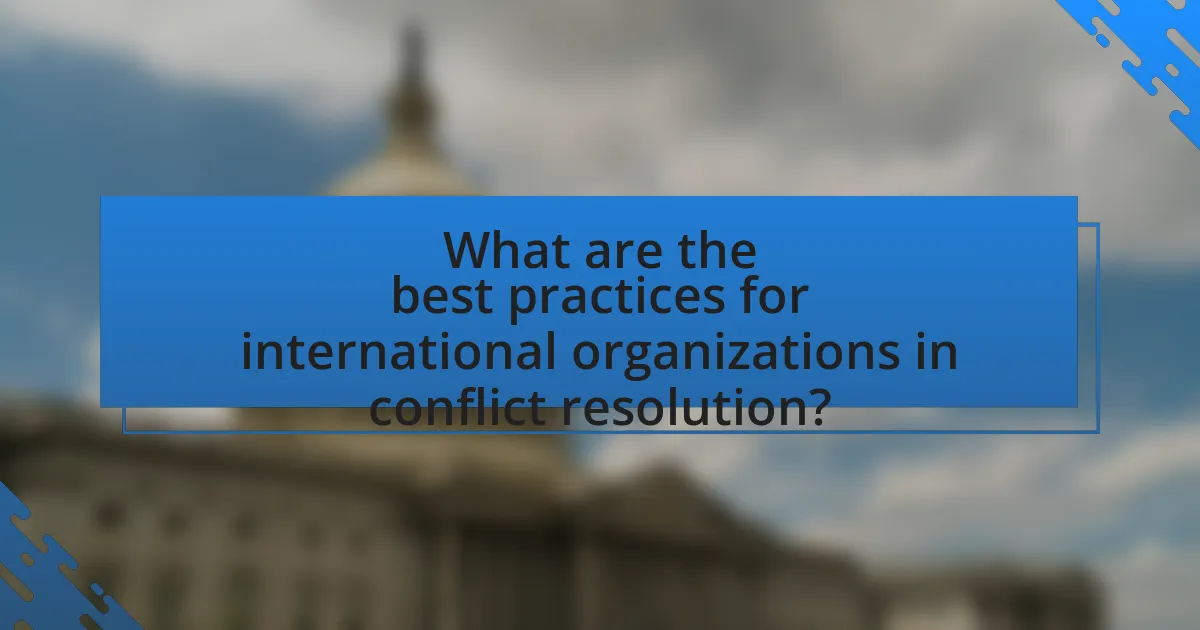
What are the best practices for international organizations in conflict resolution?
International organizations should prioritize inclusive dialogue as a best practice in conflict resolution. This approach fosters understanding among conflicting parties and encourages collaboration. For instance, the United Nations often facilitates peace talks that include diverse stakeholders, ensuring that all voices are heard, which has been shown to lead to more sustainable resolutions. Additionally, employing neutral mediators can help maintain objectivity and trust, as evidenced by the success of mediation efforts in the Camp David Accords, where U.S. mediation led to a lasting peace agreement between Egypt and Israel. Furthermore, establishing clear frameworks for accountability and monitoring can enhance compliance with agreements, as seen in the role of the Organization for Security and Co-operation in Europe in monitoring ceasefires in various conflicts. These practices collectively contribute to effective conflict resolution by promoting dialogue, neutrality, and accountability.
How can international organizations improve their mediation strategies?
International organizations can improve their mediation strategies by enhancing their conflict analysis capabilities and fostering inclusive dialogue among stakeholders. By employing advanced data analytics and conflict mapping techniques, organizations can better understand the underlying issues and dynamics of conflicts, leading to more tailored mediation approaches. For instance, the United Nations has utilized conflict analysis frameworks to identify key actors and interests in various disputes, which has proven effective in facilitating more relevant and impactful mediation efforts. Additionally, promoting inclusivity by engaging a diverse range of voices, including marginalized groups, can lead to more sustainable resolutions, as evidenced by successful peace processes in countries like Colombia, where inclusive dialogues contributed to lasting agreements.
What training and resources are essential for effective mediation?
Effective mediation requires specialized training in conflict resolution techniques, negotiation skills, and cultural competency. Training programs often include courses on active listening, emotional intelligence, and problem-solving strategies, which are crucial for understanding and addressing the needs of conflicting parties. Resources such as mediation handbooks, case studies, and access to experienced mediators enhance the learning experience and provide practical insights. Research indicates that mediators with formal training are more successful in facilitating agreements, as evidenced by a study published in the Journal of Conflict Resolution, which found that trained mediators achieved a 70% success rate in resolving disputes compared to 30% for untrained individuals.
How can they better engage with local communities?
International organizations can better engage with local communities by implementing participatory approaches that involve community members in decision-making processes. This engagement fosters trust and ensures that the initiatives align with the community’s needs and cultural context. For instance, the United Nations Development Programme (UNDP) has successfully utilized community-driven development projects, which have shown that when local populations are actively involved, project outcomes improve significantly. Research indicates that such inclusive strategies lead to higher levels of community satisfaction and sustainability of interventions, as evidenced by the UNDP’s work in post-conflict settings where local input directly influenced program design and implementation.
What lessons can be learned from past conflict resolution efforts?
Lessons learned from past conflict resolution efforts include the importance of inclusive dialogue, the necessity of addressing underlying grievances, and the effectiveness of sustained engagement. Inclusive dialogue, as seen in the Good Friday Agreement in Northern Ireland, demonstrates that involving all stakeholders fosters trust and commitment to peace. Addressing underlying grievances is crucial; for instance, the failure to resolve ethnic tensions in the former Yugoslavia led to renewed conflict. Sustained engagement, exemplified by the United Nations’ ongoing involvement in peacekeeping missions, highlights that long-term support is essential for maintaining stability and preventing relapse into violence. These lessons underscore the need for comprehensive strategies that prioritize collaboration, understanding, and ongoing commitment in conflict resolution efforts.
What successful case studies illustrate effective international organization involvement?
Successful case studies illustrating effective international organization involvement include the United Nations’ mediation in the 1995 Dayton Agreement, which ended the Bosnian War, and the African Union’s role in the peace process in Sudan, particularly the Comprehensive Peace Agreement of 2005. The Dayton Agreement was facilitated by the U.S. and NATO, resulting in a significant reduction in violence and the establishment of a framework for peace in Bosnia. The African Union’s involvement in Sudan led to a power-sharing agreement that ended decades of civil war, demonstrating the effectiveness of international organizations in conflict resolution through diplomatic engagement and peacekeeping efforts.
How can failures inform future strategies?
Failures can inform future strategies by providing critical insights into what does not work, allowing organizations to adjust their approaches. For instance, the United Nations’ peacekeeping missions have faced challenges, such as the failure in Rwanda during the 1994 genocide, which highlighted the need for timely intervention and better intelligence. This failure led to the establishment of the Responsibility to Protect (R2P) doctrine, emphasizing the importance of preventing mass atrocities. By analyzing past failures, international organizations can refine their strategies, improve operational effectiveness, and enhance their conflict resolution capabilities.
What practical steps can international organizations take to enhance their impact?
International organizations can enhance their impact by implementing targeted conflict resolution strategies, fostering collaboration among stakeholders, and utilizing data-driven approaches. For instance, organizations like the United Nations have successfully employed mediation and negotiation techniques in various conflicts, demonstrating the effectiveness of structured dialogue in achieving peace. Additionally, by engaging local communities and incorporating their perspectives, organizations can ensure that interventions are culturally relevant and more likely to succeed. Research shows that inclusive processes lead to more sustainable outcomes, as evidenced by the peace agreements in Colombia, which involved extensive participation from civil society. Furthermore, leveraging technology for real-time data collection and analysis can help organizations respond swiftly to emerging conflicts, thereby increasing their effectiveness in conflict resolution efforts.
